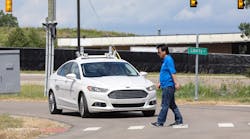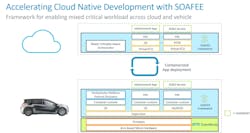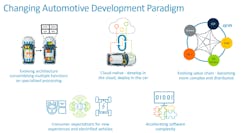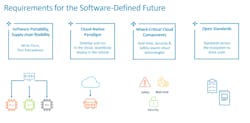Arm Rolls Out Tools To Usher in Software-Upgradeable Cars
As the modern car evolves into more of a smartphone on wheels, Arm is trying to evolve along with it.
The company rolled out a new open-standard software architecture called the Scalable Open Architecture for Embedded Edge (SOAFEE) and a reference platform based on it to help auto makers develop the “software-defined” cars of the future. Arm partnered with Volkswagen, Continental, Green Hills, and others to build out the toolset, bringing many of the methods used to develop and test software in the cloud to the auto sector.
Arm is also offering new hardware development boards that will allow car manufacturers to design and test features in areas such as the advanced driver assist systems (ADAS) or the car’s digital dashboard. Arm said the new software stack separates these features from underlying computer hardware, making applications and services significantly more portable from the cloud to the vehicle and even to other models in a lineup.
And importantly, the software works with the real-time and functional safety requirements of cars today.
Auto giants such as General Motors, Ford, Volkswagen, and others are shifting to software-centered designs in their vehicles. They want to add more advanced features and services to cars as needed through over-the-air updates, which automatically and remotely update a car’s software, like with a smartphone. Arm fits into the ecosystem because its blueprints are at the heart of many of the microcontrollers (MCUs) in cars today.
That would give car manufacturers the ability to add automated braking or other safety features or prolong the range of electric cars by updating the battery management system (BMS), potentially years after they sell the vehicle. They could also fix software flaws as vulnerabilities are uncovered or roll out services (such as running diagnostics on the car to predict when repairs are needed) that they can charge customers for.
But the challenge for the auto industry today is developing, testing, and managing all the software over the vehicle’s lifecycle and across many different models, said Chet Babla, vice president of Arm’s automotive business. While companies may update a software-defined vehicle regularly, its base hardware–the many sensors, computers, and other parts cars leave the factory with–are unlikely to change at the same pace.
Today, the most complicated cars on the road contain more than 100 electronic control units (ECUs) in all. Each has just enough computing power to perform a job in the car—everything from controlling the engine and automatic braking systems to windows, mirrors, seats, and other body controls to dashboard displays. Produced by a wide range of Tier-1 suppliers such as Continental, Valeo, and Bosch, these modules tend to run proprietary software, which is largely impenetrable even to auto makers that buy them.
But manufacturers want to move to a more central architecture, collapsing all the ECUs around their vehicles into a smaller cluster of supercomputers—what industry insiders call “domain controllers”—that will have the ability to run a wide range of features all at once. They ideally will also have enough flexibility to be upgraded over time. These will connect over the car's internal networks to a central gateway that chats with the cloud.
As part of this, they are also trying to upgrade from microcontroller-based boxes to higher-performance heterogeneous processors such as Qualcomm’s Snapdragon Ride, NVIDIA's Xavier, Infineon’s Aurix, and Renesas’s R-Car families. For instance, the Xavier chip at the heart of many advanced driver assistance systems packs eight Arm CPUs and an NVIDIA Volta GPU, supplemented by I/O ports, memory, and AI accelerator logic.
Today, microcontrollers rated for higher levels of functional safety run the advanced safety systems in cars, while separate systems carry out fewer priority workloads such as the dashboard display. But moving to a more central architecture means functions that used to require independent MCUs can now run in separate software containers instead.
According to Arm, software is increasingly vital for allowing this.
Because of its unique position in the supply chain, Arm said it has partnered with leaders in the automotive and technology ecosystem to design an open-standard architecture for future software-defined vehicles. The companies it worked with to develop SOAFEE (and reference software based on it) are Amazon AWS and Volkswagen, software makers Green Hills, Red Hat, and Linaro, Tier-1 supplier Continental, and chip vendor Marvell.
Riclef Schmidt-Clausen, a senior vice president in Volkswagen’s software subsidiary CARIAD, said that “the software-defined car is coming much sooner than anticipated and the infrastructure needed for this is being developed right now, however the industry faces some macro challenges. These include enabling software portability across a wide range of hardware platforms and building cloud-native software infrastructure.”
Arm said that auto manufacturers could use the new reference software stack to prototype, develop, and test workloads and services in the cloud and then deploy them to vehicles with support for real-time and safety-critical operations. That way, they can upgrade different features as needed and port them from one model (or generation) of cars to another without starting from scratch, saving time and costs in the process.
This new software tool supports hypervisors so that workloads in cars can run inside containers. That allows less-critical workloads with ASIL-B ratings, such as the headlights, to independently run inside the same processor as high-priority ASIL-D systems, such as the brakes, without interfering with each other. It features orchestration to manage container runtimes and make sure applications can run on any hardware.
By uncoupling the software and hardware in the vehicle, Arm is also trying to give the sector more flexibility for chip sourcing. Auto makers tend to use the same hardware as long as possible to reduce variations to the tens of millions of lines of code inside cars today. That means automotive-grade chip vendors have to keep MCUs and other chips in production for a decade or more, even as more advanced chips come out.
Today, the development of automotive-grade software must be as fast and seamless as possible. But it can still take years to develop, test, and deploy software-defined features in cars on the road, according to Arm.
Arm said it partnered with ADLink Technologies to roll out new SystemReady-based development tools to help slash the time it takes to bring software that runs on automotive-grade operating systems to market. Based on Ampere’s Arm N1-based Altra CPUs, the computers will allow workload testing and development using the SOAFEE reference software for areas such as in-car digital cockpits and advanced safety systems.
ADLink said the COM-HPC modules are compliant with Arm's SystemReady SR, which gives them out-of-the-box support from many standard operating systems, hypervisors, and software.
The high-performance AVA-AP1 module has 80 64-bit Ampere Altra CPU cores and additional I/O lanes for in-vehicle prototyping and testing. In addition, it includes a safety processor to enable in-vehicle testing with actual sensors.
The AVA developer platform is a high-performance COM-HPC computer module based on Ampere’s Arm-based Altra chip with 32 64-bit CPU cores suitable for lab-based development. It is also capable of carrying out workloads at the heart of autonomous driving features. In addition, with up to 64x PCIe Gen 4 lanes, developers can tack on accelerators for AI and other workloads to complement the Arm-based CPUs.
Arm said the reference hardware platforms are available to be pre-ordered.





